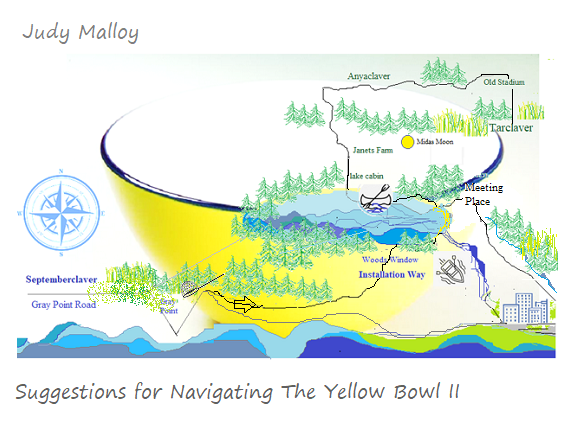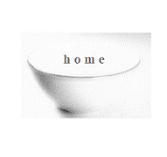
The arrows that are the primary navigation device in The Yellow Bowl are resonant of the narrator's occupation as a highway engineer, of the colored pencils that Helen carries with her, and of the flow charts that I used in coding the initial BASIC version. Additionally -- although eventually it probably becomes clear to readers that the large arrow represents the strictly sequential narrative -- the cluster of unlabeled small arrows induces readers to experience the narrative in different orders.
In the center of the main body of The Yellow Bowl II, the traditional icon for "random" produces The Grace Files. On either side, the arrows produce the sequential stories that Grace tells her daughter, Marthia. Thus, the themes of the whole are divulged both in "The Grace Files" and in the stories Grace tells about two young women, who escape from magic realistic male-centered colonies and embark on a perilous search for each other. At times, when a song is called for, an icon appears. Clicking on it will produce an aleatoric song.
The larger arrow suggests a preferred reading, but the multiple-arrow-navigation interface -- in tandem with various versions of the random icon that control the central text -- suggests that the reader is welcome to begin anywhere. This freedom from the tyranny of authorial control of reader experience is important in creating an environment where, even if a complete traversal is eventually desirable, a shorter reader experience is viable.
As the work progresses, with Evie and Zoe's gift to Clara of a copy of As You Like It, in which the pages light up as they are encountered, leaving dark pages behind them, the themes -- of banishment/exile and subsequent fluctuating identity/gender identity in the Forest of Arden -- key Helen and Clara's journey through various forests. Most of this journey is set forth in the Helen and Clara columns. But at this point, a green-colored random icon leads to a set of "The Grace Files", where otherwise unseen aleatoric passages reside.
Although it is not precisely equivalent to the original BASIC interface and structure, a clarity that resonates with the original has been retained, as have the issues with which I began in circa 1992 -- how writers of fiction distort the events of their lives and how a dichotomy of sequential text and randomly generated text can pervade a computer-mediated narrative.
Because The Yellow Bowl works within a literary constraint of sequential stories on either side and randomly generated narrative in the middle, if the reader only unfolds one character's journey, Helen and Clara will still meet at the end (as would occur in a print work if a reader skipped a chapter and would need to read the skipped chapter to follow the passage of the other character). My original intent for the 2019 version was to change TYBII into an interactive work where Helen and Clara would only meet if the reader brought both characters to the top of the hill at the same time. However, as transmediating the work progressed I saw that there was an elegance in my original intent to combine parallel serial narrative (the Helen and Clara Files) with computer-mediated aleatoric narrative ("The Grace Files). Thus I have structured TYBII in the way it was originally conceived -- as a hybrid work that explores the congruence of print and computer mediated text. Sometime in the future, I plan to continue the Helen and Clara narratives in a two-player interactive game. But this will be a new work.
Except for the soundworks (that require autoplay), The Yellow Bowl is most readable on an iPad or iPad-sized device. However, it also works well on a larger screen.





